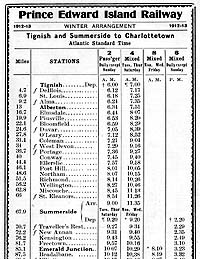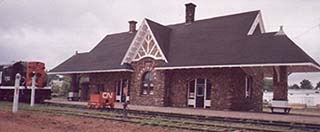









Canadian history is
inseparable from the history of the railway. The CNR is
seen as the most fundamental expression of our attempt to
build a nation, knitting together far-flung territories
and different peoples with a band of iron. In the
province of Prince Edward Island, our history is linked
just as closely with the railway, but this connection is
less of a success story. The CNR was a grandiose dream,
which ended by uniting a country despite the odds. The
P.E.I. Railway was a project as fully ambitious for a
small colony, but the odds were not as much in our favor.
The ill-conceived railway construction ended up
bankrupting the then-independent colony
 and
compelled it to accept the Confederation agreement it had
refused only six years earlier. Today, there are few
parts of the country as proudly Canadian as Prince Edward
Island. But back in 1873, the Island's entry into
Confederation was interpreted as a forced marriage, and
the overwhelming factor forcing the hand of politicians
was the railway debt. The railroad certainly worked
towards nation-building in our province: it left us with
little choice but to join Canada.
and
compelled it to accept the Confederation agreement it had
refused only six years earlier. Today, there are few
parts of the country as proudly Canadian as Prince Edward
Island. But back in 1873, the Island's entry into
Confederation was interpreted as a forced marriage, and
the overwhelming factor forcing the hand of politicians
was the railway debt. The railroad certainly worked
towards nation-building in our province: it left us with
little choice but to join Canada.
![]()
At the start of the 1870s, the Island was a
thriving and independent British colony, made prosperous
and even a little bit overconfident by the shipbuilding boom.
By 1873, it had to throw itself on the mercy of the
federal government to offload over three million dollars
worth of debt. What happened in between was the building
of the P.E.I. Railway. Many of the difficulties the
government experienced can be traced back to the
shortcomings of the original contract, which agreed to
pay the contractors per mile of track laid and failed to
specify an exact route. As a result, the builders went
around instead of through obstacles, and engaged in
under-the-table dealings to determine where the track
would make its bends. 
The result was one of the most winding and circuitous road beds in Canada. The constant need to veer left and right posed real challenges for the crew of the old steam engines, who would have to re-adjust the steam pressure to take each bend at the right speed. Adding to this already formidable task was the fact that, despite the yeoman service of rail foremen, every spring thaw would change the rails into a province-wide series of dips and humps. When the Island was converted to diesel in 1950, not many thought they would miss the unpredictable old steamers. But they soon discovered that the steam engines were not only sometimes easier to repair, but also possessed a romance and personality that the quiet, efficient diesel could never replace.
The P.E.I. Railway | The Age of Steam | The Age of Diesel | Keeping Tracks
![]()
 If the railway was
important in determining the fate of our province, it
exerted an even greater influence on the development of
Kensington. The same railway that was the undoing of the
province was the making of our community; it can honestly
be said that, without the tracks, there might not be any
town at all. Before the arrival of the rails in the
1870's, the town was no more than a village at a
crossroads, with a couple of inns
for travelers. It was a far from obvious decision to
route the rail lines through Kensington, as communities
with water frontage-- such as Margate-- were the real
commercial centres in the region at the time.
If the railway was
important in determining the fate of our province, it
exerted an even greater influence on the development of
Kensington. The same railway that was the undoing of the
province was the making of our community; it can honestly
be said that, without the tracks, there might not be any
town at all. Before the arrival of the rails in the
1870's, the town was no more than a village at a
crossroads, with a couple of inns
for travelers. It was a far from obvious decision to
route the rail lines through Kensington, as communities
with water frontage-- such as Margate-- were the real
commercial centres in the region at the time.
But thanks to a little backroom wheeling and dealing, the big bend bypassed Margate and the commerce followed the tracks right into Kensington. Businesses clustered around the town's train station, the final version of which is a beautiful stone structure completed in 1905. Perhaps the saddest day in the history of the building came on August 25, 1900 when it housed the dying David Pound, injured in a terrible train crash outside the town. While trains may no longer pull in and out of the yard, an engine will always remain there, thanks to those who rescued Engine 1762 to serve as a perpetual reminder of our rich railroad past. Once a bustling railway hub, now a heritage destination, Kensington station remains at the core of the community.
Why Kensington? | The Station | David Sabey Pound | The Moving of 1762
 Be
sure to visit our railway
museum in the
gallery.
Be
sure to visit our railway
museum in the
gallery.